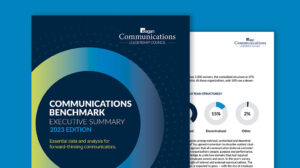Report: What your young workforce really wants
Take notes from some of the top workplaces in the country right now, as research shows shifting priorities toward job security and earning potential.

Companies are in an all-out war for talent right now.
How can you win this battle for potential employees’ attention—while also helping to shore up current staffer retention?
Universum’s new “World’s Most Attractive Employers” report has ranked what younger workers view as the world’s most desirable companies. It also identifies key workplace attributes they’re looking for amid the ongoing pandemic.
To gather this data, Universum surveyed more than 221,800 students in business, engineering and IT from the 10 largest economies between September 2020 and May 2021. The survey asks students what employer characteristics are most influential for them as they consider future employment, and which employer brands they most admire.
Some key findings include:
Young people are shifting their personal and career priorities. The pandemic is prompting students to reevaluate what they want from an employer and a career — and research shows industries with rigid, grueling schedules may face a reckoning.
Dreams of a jetset career are fading. With international mobility significantly slowed and still uncertain, students show a waning interest in foreign companies and multinational careers.
Employers must consider whether virtual work formats disadvantage younger employees. Virtual and hybrid workforces are here to stay, but talent leaders must take care not to adopt a one-size-fits-all approach — particularly with young talent, who see many potential downsides in virtual work formats. Most concerns are about isolation and lack of social contact.
Employers should consider talent “personas” as they build employer branding efforts. Some young people, for example, may be career “go-getters” who prioritize individual performance and career success, while others are “changemakers” more focused on making a positive impact on the world. Recruiting and retaining efforts should vary accordingly.
Students prioritize high future earnings above all other employer attributes. With so much uncertainty swirling around, young workers are understandably anxious about financial security. Along with the longing for high future earnings, the desire for secure employment also rose sharply in importance for young talent, jumping by as much as four ranking points for engineering students.
As for the “most attractive” companies, here’s how the respondents stacked them up:
Business Top 10
| 1. Google |
| 2. Microsoft |
| 3. Apple |
| 4. Deloitte |
| 5. L’Oréal Group |
| 6. Amazon |
| 7. Ernst & Young |
| 8. KPMG |
| 9. J.P. Morgan |
| 10. PwC |
Engineering Top 10
| 1. Google |
| 2. Microsoft |
| 3. BMW Group |
| 4. Siemens |
| 5. Apple |
| 6. GE – General Electric |
| 7. Volkswagen Group |
| 8. Intel |
| 9. Daimler/Mercedes-Benz |
| 10. Samsung |
IT Top 10
|
What the data means (for you)
According to Richard Mosely, global client director for Universum, companies must be more proactive and specific in their outreach to potential employees moving forward. That entails casting a clear vision about the opportunities you offer that can help them grow and thrive long-term.
“To attract young workers,” he says, “employers need to be clear about how they will learn and progress. This does not necessarily equate to formal training programs and career ladders. It’s more a question of clarifying the many opportunities that exist to learn from experience and explore the many possible pathways to success.”
Mosely also issues a warning about an overreliance on remote work in terms of recruiting. While the majority of the students responding to the survey expressed an openness to working remotely, many “expressed serious concerns about too much of their work being remote” and the isolation associated with a virtual setup. That desire for social contact is no small thought for companies to consider.
Universum CEO Mats Röjdmark agrees, adding that the new findings should help give talent leaders a longer view of what these trends portend. “There’s tremendous pressure on talent leaders right now to separate what are short-term reactions to COVID-19, versus long-term changes to workplace fundamentals,” says Röjdmark. “While pundits may declare that virtual work is the future of employment, young talent doesn’t usually agree, according to our research. These kinds of signals are critical for talent leaders as they negotiate a way forward in 2022.”
Lessons from an ‘attractive’ company
Kizmet Mills, senior director of Nike’s Global University Relations & Recruiting Programs, says the company focuses intently on ensuring its employees are treated well. Active engagement creates a thriving culture, which in turn fuels current and future recruiting efforts.
“Employee engagement is so important at all levels of our organization. Not only are we actively supporting our existing teammates at Nike, but it is essential to proactively attract the next generation of teammates to help define Nike’s future.”
Mills says Nike’s internal focus is on employee well-being, engagement and consistent communications – “all of which are foundational for us right now based on what the last two years have been like,” adding:
“Through well-being, we are looking at existing programs, redefining them and then developing new offerings and benefits that reflect what matters most to our employees today. That brings a level of transparency that has enabled us to support our teammates through frequent communications from Nike leaders as well as investments made in internal communication platforms to enhance employee experience and team engagement.”
Mills says candid employee feedback is essential right now.
“To ensure we are hearing the latest from our teammates, Nike’s Employee Experience and Listening & Sensing teams have several programs in place to understand what is important to employees and what we can do as an organization to meet the needs of our teammates.”
Of course, listening is just the start. To establish trust, authenticity and credibility, you should tailor messaging for your specific internal audiences. Mills explains how this all ties back to Nike’s retention and recruiting efforts:
Nike makes an effort to listen to talent while providing them with inclusive programming and curating opportunities to engage with Nike leaders, their managers and each other. Through these experiences, we put early-in-career and intern talent front and center as a critical pipeline for retention. And through sharing these authentic stories we give new and emerging talent a peek into what their Nike career would be like – and ultimately showcasing Nike as an employer of choice long into their career journey.
Over to you, readers. How are you going about recruiting and retaining young workers amid ongoing uncertainty?







